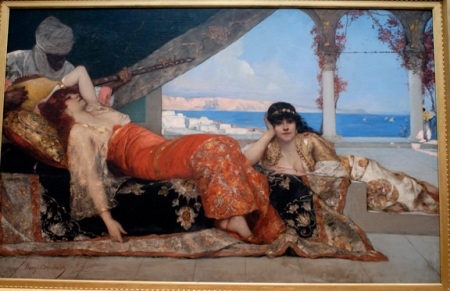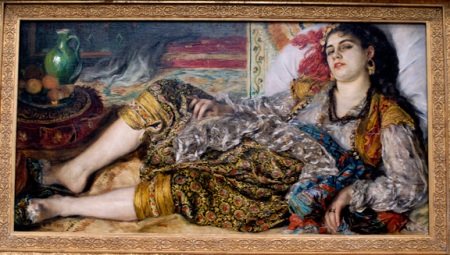
A Funeral by Eric Fischl (original in color)
Eric Fischl is America’s foremost [living] narrative painter, according to the book jacket on his autobiography, Bad Boy, co-written with Michael Stone (brackets mine – hello Edward Hopper!). I have to admit that I have never heard of him (I don’t wear my ignorance of art history proudly – but it’s more the drawback to being an erstwhile polymath). I have been reading a bit tooo much of certain types of books lately, so I decided to pick up an artist biography instead, for inspiration . . . and was recommended this one. I’ve always been one to want to know about the backstory behind an artist or writer, the psychology and experiences that inform the creation of the work. I think one of my greatest teachers, English Professor Dr. Jean Cash, did not appreciate my obsessive need to know and understand, and yet, it has been a compulsion that has taken me far afield and provided me with a joy that I have not experienced anywhere else, – to know and understand. I guess, it’s part of my lifelong quest for a common ground where empathy can be nurtured and thrive.
So with that said, I had high hopes for inspiration and transcendence. Plus he is a narrative painter fighting against the tide of abstraction and conceptual art. So I was already on his team there. He came of age in the 70s and 80s and after a few years finding himself while teaching in Nova Scotia, a move to NYC on the cusp of the 80s positioned him to become a superstar among the likes of the oft-mentioned Julian Schnabel.
What is the Fischl backstory? A severely alcoholic and narcissistic mother, who eventually commits suicide, and a dysfunctional early family life (what artist doesn’t? I’d say Thomas Kinkade, [creator of blockbuster candy-coated confections] but his well-documented alcoholism would prove a less than healthy coping system, most often attributed to attachment disorders and early childhood experiences). Fischl doesn’t dismiss the importance of those experiences to his work. His parents very open nudity amongst their children in the free-for-all 70s is also something he credits with his obsession with the nude form and I find that all informing and unfortunately, very relatable. He opens up the book with an anecdote about the nadir of his substance abuse, coinciding with the climax of his career as an artist (to date at the time), a retrospective at the Whitney when he is still in his early 40s.
He glosses over his recovery from drug and alcohol abuse (probably because he just went cold-turkey and thus had no psychological recovery – at least not off the canvas – that he is willing to relate) and this is where it starts going downhill for me. It’s not that I want to know the details of his recovery- especially as there was none – it’s just that the book loses all emotional resonance. Most of the emotion comes from vignettes about Eric supplied by his family – his siblings – and then from friends and contemporaries – (Julian Schnabel AGAIN). The most poignant being from his sister, Laurie, who writes of the transcendence she received from Eric at her father’s funeral:
Eric spoke of Dad’s awkward ways, defining with twisted hilarity who our father really was. . . I came away feeling uplifted from the sadness that was sure to be mine. I forgave Dad that day. Ever since then I have often wished I could return the favor to Eric, so he could forgive Mom.
And while the book focuses a lot on his process – his early fight with and against abstraction (it just was not him), Cal Arts back in the heyday with Ravi Shankar strumming on campus, and then making it in New York – it becomes a bit too much about the ego and who is top dog. To be fair, Fischl is never denying of his massive ego (and unmet childhood needs that create that crap), but honestly, even as he is pulling in $1 million a year in gallery sales with Mary Boone he is just pissed because Mr. Pajama Bottoms is setting all the world records for contemporary art sales. And boy, does he hate Mr. Pajama Bottoms.
I cannot relate to that at all. First off, I couldn’t name a thing Mr. PJ painted to save my life (see opening paragraph), though I am a HUGE fan of his movies. Secondly, whilst in my wayward youth – I did have publication envy and what-not to other photogs, but as soon as I found my voice – I was quite content to just pursue the work and RELIEVED – and happy to see ALL succeeding, (except for the real dickheads – but that is just because they were dickheads, not competition) because I had found something to do that gave me JOY. I don’t pull in 1/10th of one million dollars, in a year, and I care not, because I get to do what I love SOME of the time. And those photographer making slick post-produced work and building fancy homes and driving expensive cars from the proceeds, more power to them! I give them not my gaze. I care not. And I would care EVEN less if I was making a million a year. Oh boy, I really would not care at all then. I think I’d be walking around with a shit-eating grin most of the time. Because wow, I could build my own friggin’ pop-up gallery then. Probably could even do that w/o a mill, so here’s food for thought on the to-do list.
So to read Fischl going on and on about whose selling what for what and Julian, Julian, Julian (spoiler: they kiss and make up and Julian even writes a vignette to show how Kumbaya they are with each other), and with the loyal April Gornik at his side, sucking it up, being marginalized, overlooked, used by people who want to get to Fischl, he manages to become sober and spends the rest of his time talking about the decline of the art market from the 80’s stratosphere and his famous friends, John McEnroe (they trade tennis and painting lessons!), etc etc. To be sure, some of his friends are the ones I would want to have : Steve Martin – my polymathic idol; and Mike Nichols. And they all talk about his humor. It’s just not in the book. That voice isn’t there. I have no doubt, Fischl is a funny person and a great friend, just don’t look for that in the book.
I give it a C+.
As for his work, the piece that resonates with me the most is this image painted from a snapshot on the day the Fischls scattered their mother’s ashes in Arizona. I don’t think it’s a coincidence it was made from a photographic frame. Raison d’etre folks, raison d’etre.






